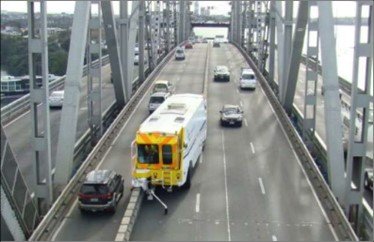The Auckland Harbour Bridge moveable lane barrier system was introduced in 1990 to provide additional capacity for peak traffic flows in the morning and afternoon rush hours.

2008 Moveable Lane Barrier Vehicle in operation. Photo WSP.
The original Moveable Lane Barrier (MLB) system was constructed on the Auckland Harbour Bridge (AHB) in 1990. It allocates an extra lane to north or south bound traffic based on predicted flows at peak times. During the morning rush when traffic is heading into the city, the system allocates five south bound lanes and three north bound lanes. This is reversed for the evening rush. On normal weekdays, the MLB system is used four times a day. Outside of the peak periods the concrete barrier is moved to the centre of the AHB to allow for four lanes in each direction.
At the time, this was the first use of a moveable lane barrier operation in the world used on a bridge with horizontal and vertical curvature.
The MLB vehicles are stored in two garages (colloquially known as the ‘elephant house’ on the North Shore, and the MLB South Garage on the southern side). These garages are located centrally at the northern end of the AHB approaches and at the southern end under the Victoria Park Viaduct. The advantage of these locations is that the MLB vehicle causes minimal disruption to the traffic flow when its starts operations.
Upgrades to the system
In February 2008, a new 2.2km MLB was installed on the AHB. This was extended in 2012 when the 1.4km St Mary's Bay string was introduced as part of the Victoria Park Tunnel project. The St Mary's Bay section and the AHB section are discontinuous and overlap.
New MLB machines replaced those that had been in service for almost 20 years. They normally operate at a speed of 6-11 km/hour, which is twice the speed of the old machines. Moving the barrier now takes 20 minutes instead of 40 minutes, so motorists benefit from a much smoother transition from one lane configuration to another.

Barrier vehicle in the ‘Elephant house.’ Photo WSP.
How it works
The MLB vehicles are purpose-built machines that straddle the concrete barrier. When undertaking a barrier shift, they engage the concrete barriers at the front right of the vehicle, lift them clear of the bridge deck/pavement, and transfer them one lane width before they exit the 15.9m long vehicle at the back left rear. A galvanised steel Variable Length Barrier (VLB) is placed every 17 units in a curve and every 67 units on a straightaway. In a curve there must be a VLB in the machine at all times for the system to work correctly.
There are 3,295 concrete units (822mm high and 1000mm long) each weighing approximately 695kg. The MLB vehicle can lift 12 tonnes which is approximately 16 barrier block elements at a time.
The MLB Guidance system consists of inductive guidance loops that are embedded into saw cuts in the surfacing. The extended arm from the vehicle has sensors that pick up the signals from the guidance loops and this provides direction for the vehicle.
Related Record entries
Entry by Murray Triggs – with information provided by WSP, the consultancy responsible for this project.



